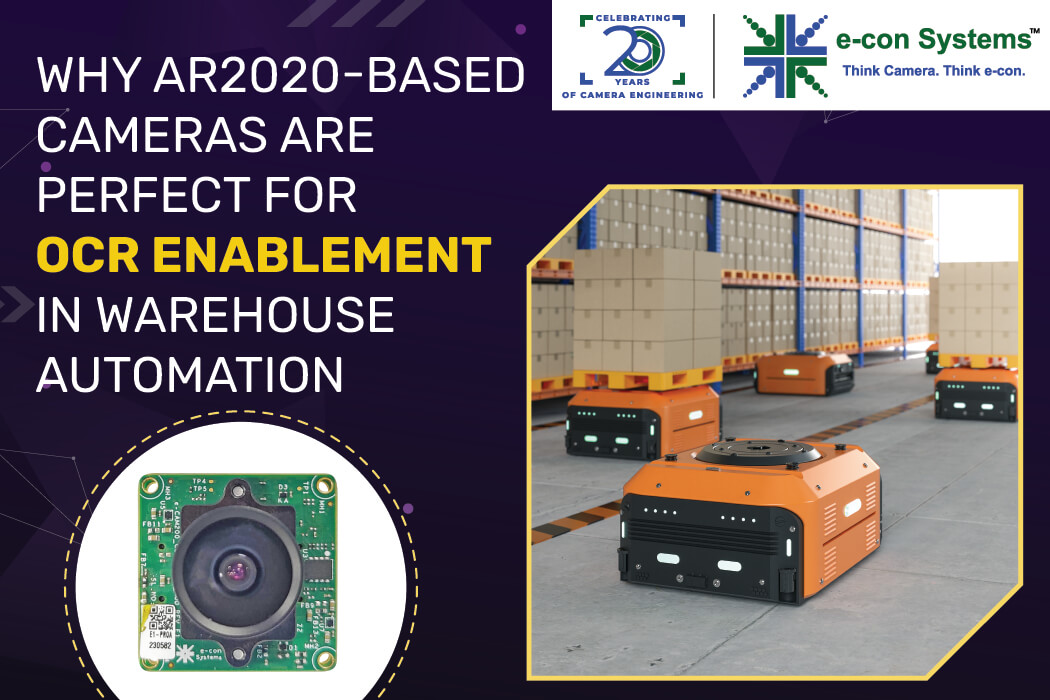Warehouse automation is progressing fast, driven by the increasing demand for convenience, speed, and accuracy in logistics operations. Among these technologies, Optical Character Recognition (OCR) has emerged as a major force, transforming how inventory management, sorting, and tracking are conducted in warehouses. OCR is primarily used to read and interpret labels and printed information on packages. This plays a crucial role in automating data entry, reducing manual errors, and speeding up processing times.
Central to this are embedded camera solutions, which have enhanced OCR capabilities on conveyor belts, marking a leap forward in automation technology.
Understanding the impact of OCR on warehouse automation
OCR technology transforms documents, such as scanned papers, PDF files, or images captured by advanced camera solutions, into editable and searchable data. Unlike traditional camera systems, embedded cameras are specifically developed to be integrated into warehouse conveyor belts.
These cameras are compact and robust and can be positioned in optimal locations to capture high-quality images of labels and barcodes as items move along the conveyor belt. This proximity enables accurate and faster OCR processing in high-speed logistics operations.
OCR technology involves several stages, starting with image capture, followed by image pre-processing, character recognition, and post-processing. The initial step involves capturing an image of the text, which is then enhanced through various pre-processing techniques like binarization, noise reduction, and skew correction.
The core of OCR is the character recognition stage, where algorithms identify and convert characters into digital text. Finally, post-processing involves error correction and data validation.
Advantages of superior OCR imaging
- Inventory tracking: Enables automated tracking of products as they move through the supply chain, enhancing inventory management
- Sorting and labeling: Facilitates automated sorting of packages based on the OCR-read information, streamlining the sorting process
- Data automation: Minimizes manual data entry, minimizing errors and increasing processing speed
Why the AR2020 sensor is necessary for OCR applications
Enhanced image clarity and detail
The AR2020 sensor offers higher resolutions, which is important for producing clearer images. Basically, it ensures that the text within the images is legible. Better resolution enhances the contrast between the text and the background, which boosts the accuracy of text recognition software.
So, when the OCR software processes high-quality images, the probability of errors in text recognition decreases, resulting in reliable extraction of data.
Smaller text recognition
One of the challenges in OCR technology is effectively recognizing small text. The AR2020 sensor helps overcome this challenge by capturing the finer details of small text in the images. It can be useful cases where documents contain fine print or when text needs to be extracted from densely packed information, such as legal documents or product labels.
The AR2020 sensor also enables OCR systems to distinguish and decode small characters, which broadens the range of documents that can be processed accurately.
Noise reduction/less distortion
High-resolution images captured by the AR2020 sensor exhibit reduced digital noise and less pixelation. Noise and distortion in images can severely degrade OCR accuracy, as they obscure the shapes and edges of characters, causing misinterpretation or misreads by OCR software.
The AR2020 sensor enhances the clarity of the text, allowing OCR technologies to perform more effectively across a variety of document types and conditions.
Scaling and cropping
With higher resolution images, OCR technologies can afford to crop or scale the visuals without significant loss of detail. Such flexibility comes in handy when specific areas of a document need to be focused on or when images need to be resized to fit the requirements of the OCR software without compromising the textual content.
The ability to maintain high-quality images after such adjustments further improves the versatility and applicability of OCR solutions across different use cases.
Integrating AR2020 sensor-based cameras into warehouse conveyor systems
The AR2020 sensor, a critical element of onsemi’s Hyperlux LP series, is highly effective for enabling Optical Character Recognition (OCR) on conveyor belts in warehouse automation. This sensor is a 1/1.8-inch stacked CMOS digital image sensor featuring a 5120 x 3840 active-pixel array. Leveraging the 1.4 μm BSI pixel technology from onsemi, it delivers high performance under varying lighting conditions, which is crucial for OCR applications in warehouse environments.
The AR2020 sensor-based cameras are, therefore, ideally suited for OCR tasks in warehouse settings. They are capable of capturing high-resolution images of labels and barcodes on packages moving along conveyor belts, which is essential for accurate and efficient data processing.
Additionally, its design prioritizes high efficiency with low power consumption, making it an optimal choice for continuous, edge-based data collection in fast-paced and energy-conscious warehouse operations.
Specific imaging use cases of OCR on conveyor belts
Package sorting
In package sorting, OCR technology reads and interprets the information on package labels to automatically sort items into different categories or destinations.
This automated sorting significantly speeds up the process, reduces human error, and increases overall performance in distribution centers.
Inventory management
OCR systems contribute to efficient inventory management by providing real-time data on the products moving through the warehouse. As items are scanned, the system updates inventory levels, ensuring accurate stock records and aiding in forecasting and replenishment processes.
This real-time tracking reduces the likelihood of stock discrepancies and enhances the ability to respond quickly to inventory needs.
Quality control and inspection
OCR technology can be employed in the quality control process within warehouses. As items pass along the conveyor belt, embedded cameras can scan and analyze labels or packaging for quality assurance purposes.
The process involves checking for correct labeling, ensuring that the product matches its description, and verifying batch numbers or expiration dates. The OCR system can quickly identify any discrepancies or errors in labeling, which are crucial for maintaining quality standards.
For perishable goods or products with a limited shelf life, the OCR system can automatically detect outdated products by reading expiration dates, ensuring that only fresh and valid products are shipped out.
Compliance checking
In warehouses that handle international shipping, OCR can play a vital role in automating the processing of customs documentation. Embedded cameras can scan and extract information from labels and shipping documents attached to packages. The OCR system can verify whether the contents of a package match the declared items in customs documents, ensuring compliance with international trade regulations.
This capability is important for warehouses that deal with a high volume of international shipments, as it streamlines the customs clearance process, reducing delays and avoiding potential penalties for non-compliance.
Additionally, for products that have specific import or export restrictions, the OCR system can flag any items that require special handling or documentation, ensuring that all requirements are met before the goods leave the warehouse.
e-con Systems offers AR2020 sensor-based cameras for warehouse automation
e-con Systems has over 20 years of expertise in designing, developing, and manufacturing OEM cameras. Our latest product, the e-CAM200_CUMI2020C_MOD, is a 20MP camera that incorporates the advanced AR2020 sensor, making it exceptionally well-suited for high-resolution imaging applications crucial in warehouse environments.
This camera excels in the changing lighting conditions typical of warehouses, taking full advantage of our expertise in Image Signal Processing (ISP). The result is superior image quality for ensuring accurate sorting, tracking, and management of inventory.
Please check out our Camera Selector Page to find the best-fit camera for your applications.
Browse our Markets page to fully understand our end-to-end capabilities.
Reach out to us at camerasolutions@e-consystems.com if you need expert help integrating camera solutions into your warehouse automation systems.

Gomathi Sankar is a camera expert with 15+ years of experience in embedded product design, camera solutioning, and product development. In e-con Systems, he has built numerous camera solutions for robots, industrial handhelds, quality inspection systems, smart city applications, industrial safety systems, and more. He has played an integral part in helping hundreds of customers build their dream products by integrating the right vision technology into them.




